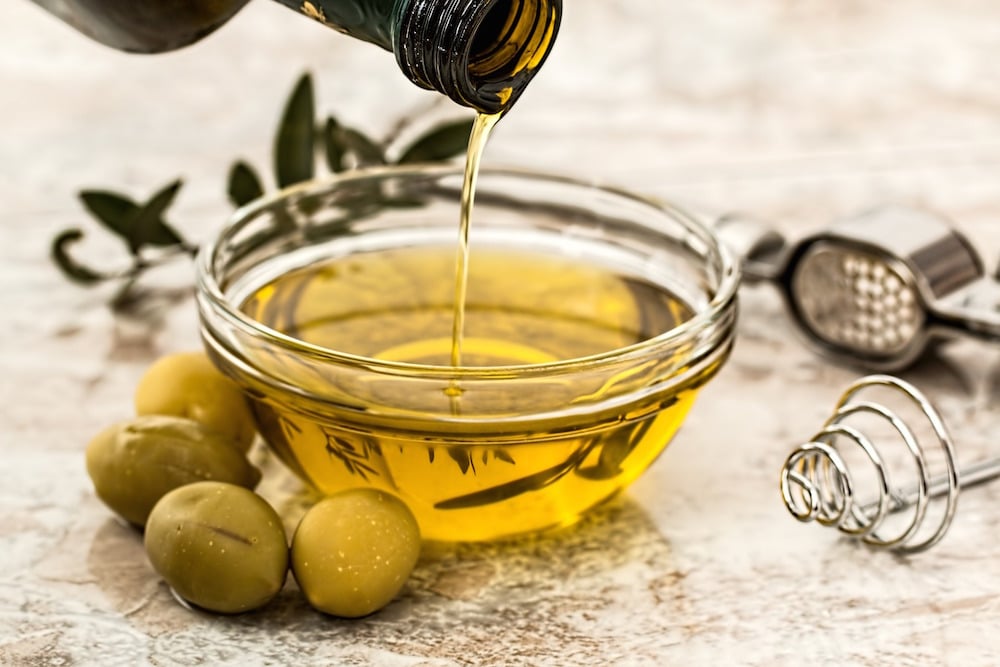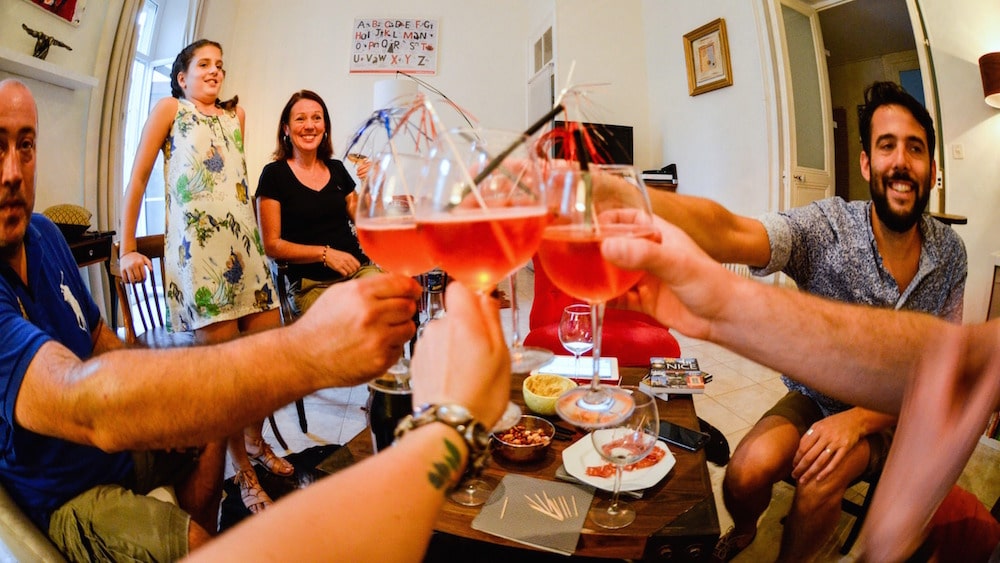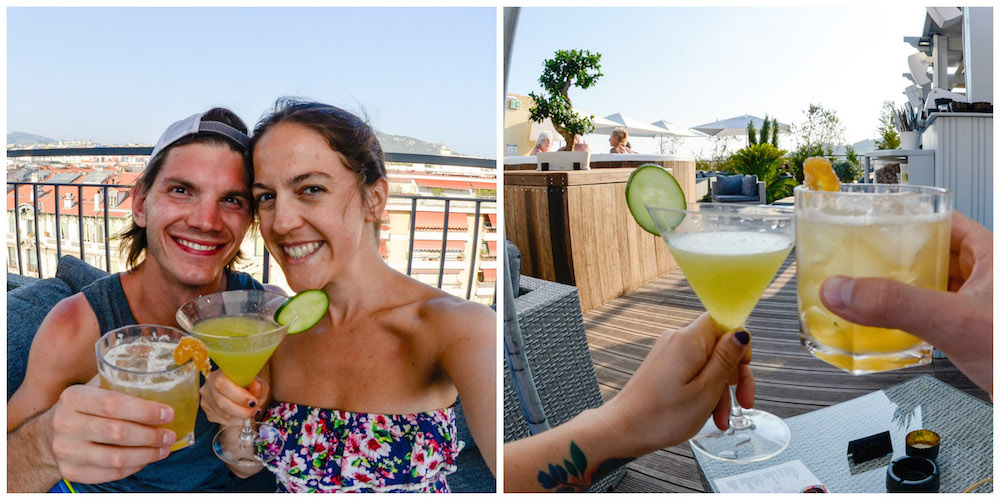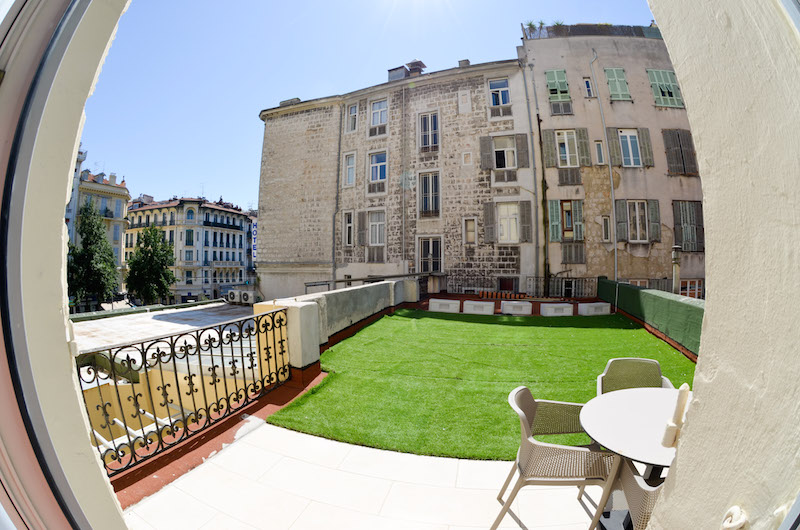By Jessica Festa, Epicure & Culture Editor
Walking along Nice’s iconic Promenade des Anglais, Hard Rock cafes, casinos and beachfront cafes offering crepes and margaritas try to entice my boyfriend Andy and I with colorful signs boasting 100 cocktails and stunning beach views. We admire the scenery of the beautiful rocky beach and its azure waters, but continue on until the wide walkway becomes the narrow winding streets of Old Town. Suddenly, we’re shaded by charmingly weathered yellow and ochre baroque buildings donning whimsical shutter windows as well as overhangs from small local restaurants, bars and boutiques.
It’s here in the oldest part of Nice where we try typical Nice delights at A Buteghinna, one of less than 20 restaurants in the city to hold the “Cuisine Nissarde” certification. The title means the restaurant focuses on the traditions of Nice’s culinary heritage, a facet of the culture we’re privy to through a platter of typical tastings. Many people think of “French cuisine” as one type of food; however, the country’s diverse climate and geography leads to regional differences.
A Story In A Dish
It’s amazing how much a dish can tell you about a place. For example, Italian influences due to Nice’s proximity to Italy and its past as part of the House of Savoy (later the Kingdom of Piedmont-Sardinia, which became part of Italy) means you’ll find similar recipes between Nice and Liguria and Piemonte, the two regions on the border. For instance, in Liguria you’ll find the farinata and in Nice there’s the socca, both unleavened pancakes of chicpea flour, with the recipe originally from Genoa. Moreover pesto genovese is like la taponade niçoise. The former is made with fresh basil from Genova, pine nuts, garlic, Pecorino or Parmesan cheese and Ligurian olive oil, while the Pistou Niçois contains basil, garlic, olive oil and mountain cow cheese (Parmesan or Sbritz), though is void of pine nuts. There’s also Ligurian la fugasse which is like fugasse Niçoise, and Ligurian la torta di cipolle is like la pissaladière, to name just a few more examples.

The generous use of herbs and olive oil in Nice over butter is different from cities like Paris, Brittany, Burgundy and Bordeaux. Like in Italian peasant cooking and the Mediterranean in general, traditional recipes are simple but bursting with flavor, letting fresh ingredients like eggplant, artichoke, tomatoes and peppers do the talking. Some other dishes savored at A Buteghinna include ratatouille, stewed vegetables with olive oil, basil and balsamic vinegar; pissaladière, a caramelized onion and anchovy tart; petits farcis, a meat and veg-stuffed vegetable; and panisse, chic pea flour fries.
The meal ends with a dessert most of my fellow Americans would bat a confused eye to at first, a Swiss Chard pie. Vegetable-laced desserts aren’t super common in the United States outside of carrot cake and sweet potato pie, though with one bite I’m surprised how sweet-over-earthy it is. This is due to the complex recipe including dried raisins, apples and pine nuts in a sweet brown-sugar laced pie crust made with olive oil.
Nice Street Food
In the more modern part of Nice we head to Place Gal de Gaulle, a square surrounded by a Provence-style morning market with fresh produce, beautiful flower bouquets and local seafood. Here you’ll also savor some of Nice’s best typical street foods, like le pan bagnat at Kiosque TinTin — essentially a Salade Niçoise done sandwich style — and socca from Soccatram. The latter may sound simple, fried chic pea flour topped with a bit of salt and pepper, but it’s seriously amazing. At 3 Euros per serving, it quickly became a budget-friendly addiction.

Dining Hyper Local
Now I’m of the thinking that if you haven’t interacted with the locals, then you haven’t really visited a place. Thanks to BonAppetour, a platform connecting travelers with local chefs to dine in their homes, Andy and I have a delicious local dinner in the beautiful art-adorned apartment of Caroline and Nicolas. The couple greets us with big glasses of French rosé immediately upon arrival. That is, until their friend Teddy — aka “The Spritz King” — arrives and makes us Spritz’s, a mix of Prosecco and Aperol. The evening lasts five amazing hours as we explore Nice through food, while also discussing culture and sharing stories over drinks.
This exchange of culture is where Andy and I learn our most important lesson as visitors to France. After some back and forth with the hosts, it becomes clear that France has certain rules when it comes to pleasantries. When you walk into a venue, whether it be a shop, hotel bank or something else, you always say “bonjour miss/sir” (hello madame / monsieur), as well as “au revoir madame / monsieur,” (goodbye miss/sir) when you’re leaving. Frequent use of the words “merci” (thank you) and “s’il vous plaît” (please) are also important.

Nice’s culinary exploration isn’t all typical, however. For example, at Rooftop #7 at the Hotel Monsigny — highly recommended for a stay, as well — we sip craft cocktails in a chill rooftop lounge. A spicy “Amante Picante” with tequila, coriander and jalapeños is the perfect compliment to the aerial views, relaxed lounge music and tasty cheese platters. A Jacuzzi overlooking the city (5 Euros) adds to the allure of the experience.

Then there’s possibly the most decadent meal of the trip at Le Vingt4, a modern restaurant sourcing the best regional ingredients from around the world. Think Black Angus ribeye from Argentina and ricotta and spinach-filled ravioli topped with 24-month-aged Parmigiano Reggiano, all placed into dishes crafted with minimal cooking and paired with regional wine.
As I bite into a winter truffle-laced brie, paired perfectly with a Champagne Herbert Grand Cru that changes flavor with each bite of cheese, I think about what Nice cuisine is. Yes, there are the traditional dishes to try, showing you where the city came from; but there are also the more modern restaurants paying homage to France while also celebrating the world’s flavors. France’s Mediterranean location and proximity to Italy means you’ll find lots of olives, wine and Italian cheeses, though its modern melting pot means Indian spices, Argentinian meats and Middle Eastern dips are also part of daily life. Savoring both past and present allows for a true culinary journey through Nice history.

Logistics:
Stay: From the outside, the Hotel Monsigny Nice appears like an apartment building with towels billowing from terraces and a cute sidewalk restaurant, though if you look up and to the left you’ll see the vertical block letter “HOTEL” sign. The 3-star rating keeps it affordable, but awesome amenities along with the restaurant include a 7th-floor rooftop cocktail bar and Jacuzzi (5 Euros for guests to use), open marble showers and, if you stay in the Superior Balcony room like we did, your very own enormous terrace with table patio and turf grass for picnicking while enjoying Nice’s architecture.
Starting rates: $65-$201 for the lowest class room. For a Superior Balcony room it’s $92 to $310 USD (2-person room) or $128 to $419 (4-person room).
Driving In Nice: French drivers make New York drivers seem sane and polite. Driving in Nice was extremely stressful with skinny streets, minimal parking aside for garages, and pedestrians and motorbikes that seemed to have a death wish. While I recommend having a car to travel the South of France, it’s best to spend a few days in Nice traveling on foot (it’s very walkable), bus and tram, and then picking up the car when you’re ready to do your day trips or journey onward.
Parking: If you have a car in Nice get a paid parking spot. The one offered by Hotel Monsigny costs 16 Euros (~$18 USD) per night but the garage is SO tight it took two of us and about 30 minutes (literally) to get out. Unless you have a really small rental car get a spot at a public lot (24-27 Euros / ~$27-$30 USD, with the first 30-60 minutes typically free).
Pleasantries: The French get a bad reputation for being rude; however, if you say “bonjour” (hello) and “au revoir” (goodbye) as well as pleasantries like “merci” (thank you) and “s’il vous plaît” (please) you’ll have a completely different experience. We went from being ignored to treated wonderfully once we applied this tip to our trip.
Language: The official language is French, though many people also speak English. As long as you use the above pleasantries most people are happy to chat with you, help you and even try to communicate when there’s a language barrier.
Safety: I know many of you interested in Nice may be worried about safety in light of the tragic July 2016 terror attacks in the city. We are sadly living in a time when going on vacation has lost its worry-free appeal. Andy and I felt very safe in Nice, and recommend anyone with flights booked or thinking about booking flights to the South of France not cancel their plans. Threats are everywhere. You can’t stop living your life. For more information on this, I urge you to read Wendy Perrin’s excellent post on “7 Keys To Traveling Without Fear Despite Terrorist Attacks. Please also visit my personal travel blog’s Safety Essentials page.
Great Reads:Au Contraire: Figuring Out the French and How the French Think: An Affectionate Portrait of an Intellectual People.
Safety Essentials: While I found Nice to be relatively safe, I always travel with Clever Travel Companion Pickpocket-Proof Garments and a ROBOCOPP Personal Grenade Alarm ($6 off with code “JOURNEY10”!).
Language: French, though we found many people spoke some English. Just make sure to understand pleasantries when interacting with locals!
Currency: Euro. As of October 2016 the exchange rate was about 1 Euro = $1.10 USD.
France Road Trip Route:
- Nice (with day trips to Eze for a medieval village, Monaco for a VIP afternoon and Saint-Jean-Cap-Ferrat for the Villa & Jardins Ephrussi de Rothschild)
- Cannes (with day trips to St. Tropez/Ramatuelle for beaches, Gassin for wine tasting and La Croix Valmer for beaches and hiking)
- Moissac Bellevue (we stayed at a woodland set horse farm then were about 20-minutes from Verdon Gorge)
- Hyeres (the cobbled commune itself is fun to explore, and is near beautiful beaches and is accessible to the untouched Port Cros Island; worth the trip for this cool castle stay alone!)
- Aix-en-Provence (my personal favorite spot of the trip due to the small quiet city full of amenities and accessibility to beautiful Provence farmland; a cheesey rooftop lunch at La Fromagerie Du Passage and a day trip cycling outside the city with Arthur of Secrets d’ici are musts!)
- Marseille (don’t miss hiking in the urban Calanques National Park, which doesn’t feel urban at all and is accessible to beautiful port towns and beaches)
*This post originally appeared on Epicure & Culture



